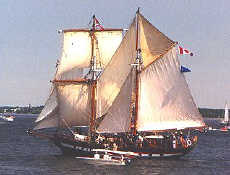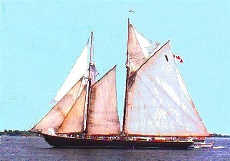 |
Kingston’s St. Lawrence II youth sail training brigantine is one of this host city’s ships at the 2001 challenge, sponsored by the American Sail Training Association. |
![]()
“I must go down
to the sea again,
to the lonely sea and the sky,
And all I ask is a tall ship
And a star to steer her by…”
Can anyone fail to be stirred at the sight of a tall ship with billowing sails, as it appears over the horizon and glides majestically through the water? Instantly the ship reminds us of where mankind has been, of the technical progress we have made over the centuries – and of our longing for a simpler time, when Nature was our constant friend and foe on our voyages of discovery. Even the most jaded among us can’t help revealing a glimpse of their romantic side, usually so carefully hidden from view.
The rare occasions when several of these great vessels come together is truly a magical event. Among their historic gatherings last year was one in Halifax, Nova Scotia, which included the world’s great three- and four-masted windjammers. Unfortunately I wasn’t free to travel at the time, so when word came of a “Great Lakes Tall Ships Challenge” this summer involving over twenty two-masters from Canada, the US and Europe, I determined not to miss out again. Fortunately this multi-destination international race for brigs, brigantines, barquentines, schooners and others began this time in the nearby historic city of Kingston, on the Canadian side of Lake Ontario, so I didn’t have far to go.
This “challenge” is sponsored by the American Sail Training Association, whose main purpose is to give youth and interested adults the chance to learn teamwork and pursue self-development while enjoying the experience of a lifetime crewing these magnificent vessels. There are four “races”, each about 130 miles in length, with the winners determined by a complex handicapping system. It’s more than just a “race” though; there are several good-will educational stops along the way. The days spent in various ports offer an opportunity for people in Ontario, Ohio and Michigan to learn about and visit a part of their heritage that they wouldn’t normally see. Ports of call include Kingston, Port Colborne, Cleveland, Windsor-Detroit, Bay City, Mackinac City, and Muskegon.
No doubt Kingston was chosen as the first stop because of its historical significance as the first capital of Canada, its vast wealth of 19th century architecture, the potential for events offered by its military sites, and the date (the Canada Day weekend). In addition to sail-pasts and on-deck tours there were concerts, a sports competition against cadets of the Royal Military College, and a mock assault by the brig Niagara against historic Fort Henry. (That was something which could have actually happened, but didn’t, during the War of 1812). The crews also took part in Kingston’s Canada Day parade. Events of similar significance are planned at the other ports of call; in Detroit, for example, it’s the 300th anniversary of the city’s founding.
 |
At 125 feet (38 meters) from mainmast to deck, the Bluenose II is Canada’s proudest tall ship. |
![]()
Among the many tall ships, two are particularly significant: the schooner Bluenose II and the US Brig Niagara. Many think of the Bluenose II as “Canada’s flagship”, since its namesake has graced the Canadian dime for more than half a century. It’s an exact replica of the original Bluenose, which dominated races for the International Fisherman’s Trophy from 1921 to 1938; however, it sank on a reef during World War II. The US Brig Niagara is a replica of the flagship of the great American naval officer Oliver Hazard Perry (no relation), of “don’t give up the ship” fame at the Battle of Lake Erie during the War of 1812. Seeing these two vessels was both a delight for me and the source of my greatest disappointment – but more about that later. There is more information about the Bluenose II at their web-site, www.bluenose2.ns.ca.
Now for the biggest disappointment of my life. I went to photograph the ships twice, once on their June 28 arrival, and again on their July 2 departure. For the arrival I took a 70-210mm lens which, as the photos show, worked fine for most of the ships. The Niagara was too large and too close to get it all in, so I decided to bring a 35-70 one and get it during their departure sail-past. Much to my horror, when it finally sailed out I discovered that I’d already used up the entire film. I tell you, my rear end is still black and blue from kicking myself! For those who don’t know what that great ship looks like, their web site is at www.brigniagara.org.
Much of the challenge race has now been completed, but you may still be able to catch them at Windsor-Detroit July 26-30; at Bay City, MI, July 26-30; or at Muskegon, MI, August 9-13. Or you may see them in transit between these dates. In any event, this is a rare opportunity for those who don’t live on the coast to see some of the finest examples of what sailing is all about.